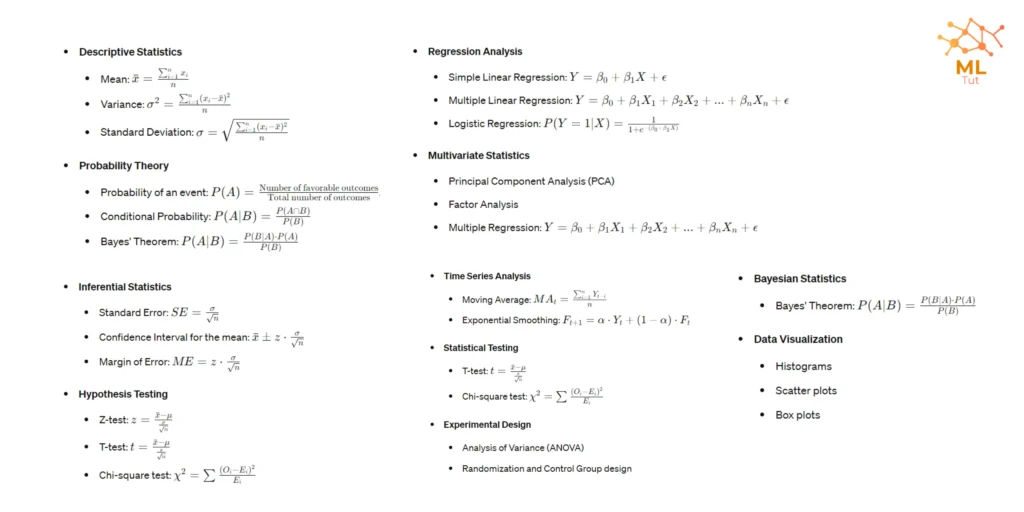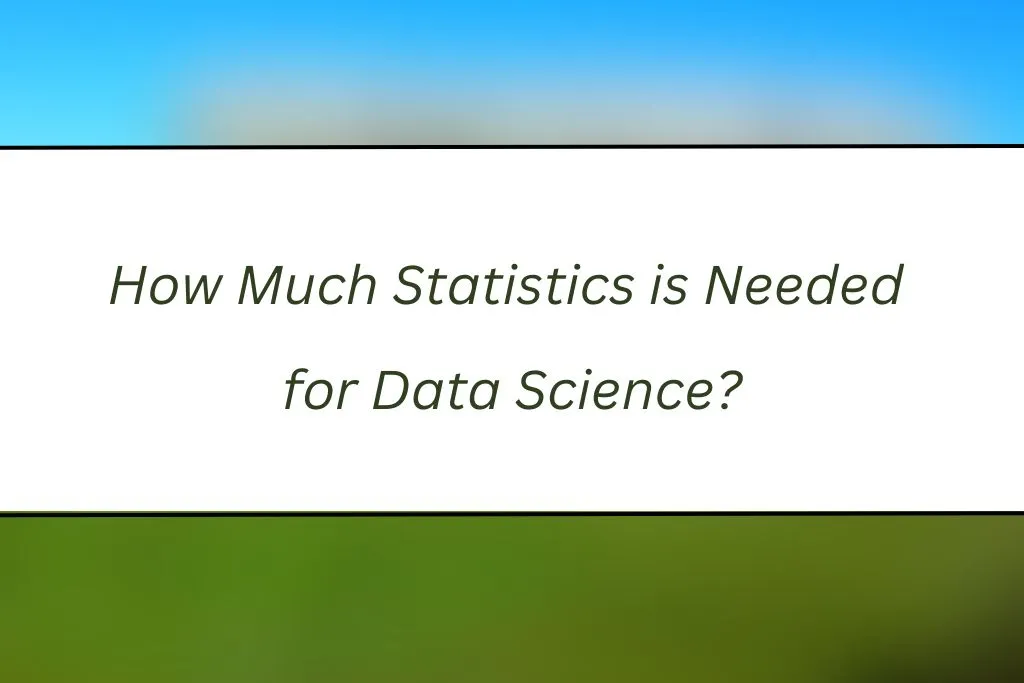Do you want to learn Statistics for Data Science but have a doubt about “How Much Statistics is Needed for Data Science?”… If yes, then this blog is for you. In this blog, I will share everything you need to learn in Statistics for Data Science. Along with that, I will share the resources I used during my statistics learning journey. I will try to share my learning experience with statistics with you.
So, without any further ado, let’s get started-
How Much Statistics is Needed for Data Science?
First, let’s see why Statistics is required for Data Science-
Why Statistics is Important for Data Science?
As someone who has studied statistics and applied it in my data science projects, I have found statistics to be very important. Here’s why:
- Data Collection and Sampling: In my projects, gathering data is often the first step. Proper sampling techniques, like random sampling, ensure that the data is representative and unbiased. This makes the data reliable for analysis.
- Data Analysis: Descriptive statistics are essential for summarizing data. Measures like the mean, median, mode, variance, and standard deviation help me quickly understand the main characteristics of the data. These summaries provide a clear overview of the data.
- Inferential Statistics: When I need to make predictions or generalize findings from a sample to a larger population, inferential statistics are crucial. Techniques such as hypothesis testing and regression analysis allow me to draw meaningful conclusions from the data.
- Identifying Patterns and Trends: Statistics helps me uncover patterns and trends within the data. For instance, time series analysis reveals trends over time, while clustering techniques identify natural groupings in the data. These insights are key to solving complex problems.
- Building Predictive Models: Many projects involve building models to predict future outcomes. Statistical methods like linear regression and logistic regression are essential for creating accurate predictive models. Understanding these methods helps me build reliable models.
- Handling Uncertainty: Data often comes with uncertainty. Statistical tools, such as probability distributions and confidence intervals, help me quantify and manage this uncertainty. This is especially important in risk assessment projects.
- Evaluating Models: After building models, it’s important to evaluate their performance. Statistical metrics like accuracy, precision, recall, and F1 score help me assess how well a model is performing and identify areas for improvement.
- Data Visualization: Effective communication of data insights is crucial. Statistics guides me in creating clear and accurate visualizations. This ensures that the data is presented in a way that is easy to understand for stakeholders.
- Decision Making: Statistics enables me to make data-driven decisions. By applying statistical analysis, I can support my recommendations with solid evidence. This approach leads to better and more reliable outcomes in projects.
- Ethics and Bias Detection: Statistics also helps in identifying and correcting biases in data. Ensuring fairness and avoiding discrimination are essential, especially in projects that impact society.
In conclusion, my experience with statistics in data science has shown that it is a fundamental part of the field. It provides the necessary tools to turn raw data into meaningful insights, enabling data scientists to make informed and effective decisions.
Now, let’s come to your main doubt “How Much Statistics is Needed for Data Science?“
How Much Statistics is Needed for Data Science?

In my opinion, you need to learn these topics in detail for Data Science-
- Basic Descriptive Statistics: You need to understand basic descriptive statistics, including measures like mean, median, mode, variance, and standard deviation. These basics help you summarize and get a quick overview of the data.
- Probability Theory: You should grasp probability well. Understanding concepts like probability distributions, conditional probability, and Bayes’ theorem is important for making predictions and dealing with uncertainty in data.
- Inferential Statistics: You need to know how to draw conclusions about a population based on a sample. This involves learning about hypothesis testing, confidence intervals, and p-values. These techniques allow you to make inferences and decisions based on data samples.
- Regression Analysis: You must know how to perform and interpret regression analysis, including both linear and logistic regression. Regression models help you understand relationships between variables and make predictions.
- Multivariate Statistics: You should understand how to analyze data involving multiple variables. Techniques like principal component analysis (PCA) and cluster analysis help you deal with complex datasets and extract meaningful patterns.
- Time Series Analysis: If you work with data that changes over time, you need to understand time series analysis. This includes methods for identifying trends, seasonality, and making forecasts.
- Statistical Testing: You need to be familiar with various statistical tests, such as t-tests, chi-square tests, and ANOVA. These tests help you compare groups and determine if observed differences are statistically significant.
- Experimental Design: You should know how to design experiments and analyze experimental data, especially for A/B testing or other types of controlled experiments. This includes understanding randomization, control groups, and blinding.
- Bayesian Statistics: While not always required, understanding Bayesian statistics can be very useful. Bayesian methods provide a different approach to probability and statistical inference, often leading to more intuitive results.
- Data Visualization: You need basic knowledge of statistical principles in data visualization. This includes understanding how to accurately represent data and avoid misleading visualizations.
Now, let’s see the resources to learn Statistics-
Resources to Learn Statistics
| S/N | Course Name | Rating | Time to Complete |
|---|---|---|---|
| 1. | Intro to Statistics– Udacity (FREE Course) | NA | 2 Months |
| 2. | Statistics with R Specialization– Duke University (Coursera) | 4.6/5 | 7 Months |
| 3. | Practical Statistics– Udacity | 4.7/5 | 35 hours |
| 4. | Statistics with Python Specialization– University of Michigan (Coursera) | 4.5/5 | 3 months |
| 5. | Statistician with R– Datacamp | NA | 108 hours |
| 6. | Introduction to Statistics– Coursera (FREE Course) | 4.5/5 | 15 hours |
| 7. | Data Science: Statistics and Machine Learning Specialization– Johns Hopkins University (Coursera) | 4.4/5 | 5 Months |
| 8. | Statistics Fundamentals with R– Datacamp | NA | 20 hours |
| 9. | Statistical Analysis with R for Public Health Specialization– Imperial College London (Coursera) | 4.7/5 | 4 Months |
| 10. | Basic Statistics– University of Amsterdam (Coursera) | 4.7/5 | 26 Hours |
| 11. | Statistics Fundamentals with Python– Datacamp | NA | 19 hours |
| 12. | Learn Statistics with Python– Codecademy | NA | 15 hours |
| 13. | Intro to Inferential Statistics– Udacity (FREE Course) | NA | 2 Months |
| 14. | Intro to Descriptive Statistics– Udacity (FREE Course) | NA | 2 Months |
| 15. | Introduction to Bayesian Statistics– Udemy (FREE Course) | 4.8/5 | 1hr 19min |
Should I learn statistics before data science?
Before learning data science, I made sure to learn statistics first, and I did it alongside my data science studies. This approach helped me understand how statistics is used in real-life data analysis. Learning statistics beforehand gave me a strong base. Concepts like probability, hypothesis testing, and regression analysis became familiar to me, and I could see how they are important in data science.
Studying statistics alongside data science also helped me see how these concepts work in practice. For example, understanding probability distributions was important for using machine learning algorithms effectively. Also, learning about hypothesis testing helped me make smart decisions about model performance.
Moreover, studying statistics alongside data science helped me become better at critical thinking. I learned to look at data carefully, spotting mistakes and biases. This skill has been really useful as I’ve worked with different datasets.
In short, learning statistics before jumping into data science was a smart move. It gave me a strong foundation, practical skills, and a sharper eye for detail, all of which have been really helpful in my data science journey.
Is statistics hard in data science?
Is statistics hard in data science? Well, from my experience, it’s a bit of a mixed bag. Understanding statistics is important for data science, but some parts were trickier for me than others.
Probability theory and hypothesis testing were tough cookies. Wrapping my head around abstract concepts like probability and the ins and outs of hypothesis testing took some extra effort. But with practice and breaking things down into smaller chunks, I eventually got the hang of it.
However, some topics were smoother sailing. Descriptive statistics, for instance, felt more straightforward. Learning about stuff like mean, median, and mode made sense to me right off the bat.
Getting hands-on with real-world data science projects also helped. Using regression analysis to predict things like housing prices or sales trends made the theory feel more concrete and easier to grasp.
In the end, while some parts of statistics were tough, I found that persistence and practice paid off. Taking it step by step and not being afraid to ask for help when needed made all the difference.
How long does it take to learn statistics for data science?
How long does it take to learn statistics for data science? Well, it varies for everyone. From my experience, it’s not something you can rush through—it takes time to really understand the ins and outs.
For me, it took about 4 months of dedicated learning to properly grasp everything about statistics. I took it slow and steady, breaking down each concept into manageable pieces and ensuring I fully understood each one before moving on.
Others might pick it up quicker, especially if they have a knack for numbers or prior experience with related subjects. It depends on factors like how much time you can dedicate to learning, your background knowledge, and how you prefer to learn—whether it’s through books, online courses, or hands-on practice.
But here’s the thing: don’t rush it. Take the time you need to truly understand each concept. Break things down into smaller, more manageable pieces, and don’t be afraid to ask for help if something doesn’t click right away.
In the end, it’s not about how fast you learn—it’s about how well you understand statistics and how you can apply it to data science. So take your time, stay patient, and keep pushing forward. You’ll get there eventually!
Conclusion
So, I have shared everything related to my statistics learning journey with you. I hope it will help you and clear your doubts about “How Much Statistics is Needed for Data Science?“. If you have any doubts or queries, feel free to ask me in the comment section. I am here to help you.
All the Best for your Career!
Happy Learning!
You May Also Be Interested In
10 Best Online Courses for Data Science with R Programming
8 Best Free Online Data Analytics Courses You Must Know in 2025
Data Analyst Online Certification to Become a Successful Data Analyst
8 Best Books on Data Science with Python You Must Read in 2025
14 Best+Free Data Science with Python Courses Online- [Bestseller 2025]
10 Best Online Courses for Data Science with R Programming in 2025
8 Best Data Engineering Courses Online- Complete List of Resources
Thank YOU!
To explore More about Data Science, Visit Here
Though of the Day…
‘ It’s what you learn after you know it all that counts.’
– John Wooden
Written By Aqsa Zafar
Aqsa Zafar is a Ph.D. scholar in Machine Learning at Dayananda Sagar University, specializing in Natural Language Processing and Deep Learning. She has published research in AI applications for mental health and actively shares insights on data science, machine learning, and generative AI through MLTUT. With a strong background in computer science (B.Tech and M.Tech), Aqsa combines academic expertise with practical experience to help learners and professionals understand and apply AI in real-world scenarios.

